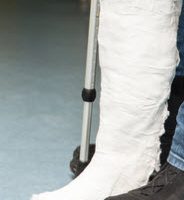What is a Compound Fracture?

Many people involved in traumatic accidents suffer a compound fracture. These fractures are called “compound” because there is accompanying damage to the skin or tissue around the bone. Typically, the broken bone will become exposed through the wound, though this isn’t required. The break in the skin is either caused by the trauma that broke the bone or by the bone itself.
If you suffer a compound fracture, you need to receive prompt medical attention. Any delay could cause the situation to worsen.
Signs You Have a Compound Fracture
Sometimes, you might not know that you have broken a bone, especially if it doesn’t protrude. You might see holes in your skin but not bone and not really know what has happened. Pay attention to the following symptoms, as identified by Health Hype:
- A foul odor. This could be the sign of an infection and gangrene.
- Pain and/or contraction. For example, your toes might curl back, which is a sign that tissue is tightening due to compartment syndrome.
- Reduced blood flow to the injured limb.
Also pay attention to pain. If it hurts to step on one leg, then you might have broken a bone in the leg. You should certainly go to the hospital to be checked out.
Complications from Compound Fractures
These types of breaks present two problems that can quickly escalate:
- You lose a lot of blood from the wound. When you break a bone, blood clots form quickly, and blood loss is limited by tissue compartments. But with a compound fracture, the blood can pour freely out of the wound and clot formation is frustrated or delayed.
- Your wound can become infected if it is not cleaned and closed quickly.
Go to the hospital as soon as possible so that your wound can be treated. Your doctor will assess the injury and might need to order an X-ray to identify whether you have broken a bone.
Treating a Compound Fracture
Your treatment will depend on how the bone has broken and how advanced any infection is. Generally, the doctor will try to align the bones so that they can heal by using internal or external fixation. Internal fixation might require inserting pins, screws, or plates to hold the bones together and keep them aligned.
A doctor will also need to treat any infection, usually using antibiotics. If infections is severe and cannot be treated, then the affected limb might need to be amputated.
Even after the bone heals, a patient will often need physical therapy to help them regain muscle strength, flexibility, and mobility. Compound fractures in the legs could take much longer to recover from than one in the arms or upper body.
Compensation for a Compound Fracture
If you suffered a fracture as part of an accident, then you might bring a lawsuit to receive compensation. At Earnhart Law, many of our clients have received money for medical care, lost wages, and pain and suffering. Please contact us today to learn more.
We offer a free consultation with one of our Delray Beach personal injury lawyers. You can schedule your meeting by calling 561-265-2220.
Resource:
healthhype.com/compound-fracture-symptoms-treatment-and-complications.html
https://www.delrayinjuryattorneys.com/dui-fatalities-what-are-the-most-dangerous-florida-cities/
